Comparison of Metal Lids and Tattler Lids (Reusable Lids)
This post may contain affiliate links. Read my full disclosure here.
Given the current canning lid shortage, I decided to update this comparison of Jarden Metal Lids and Tattler Reusable Canning lids. We’ll talk about some background information, how to use reusable lids, concerns, and recommendations.
I sent email questionnaires to both Jarden and Tattler. Jarden representative Judy L. Harrold, Manager, Consumer Affairs, responded quickly. We also arranged a phone interview.
Tattler declined to comment, so I pieced together information from their website and other online sources.
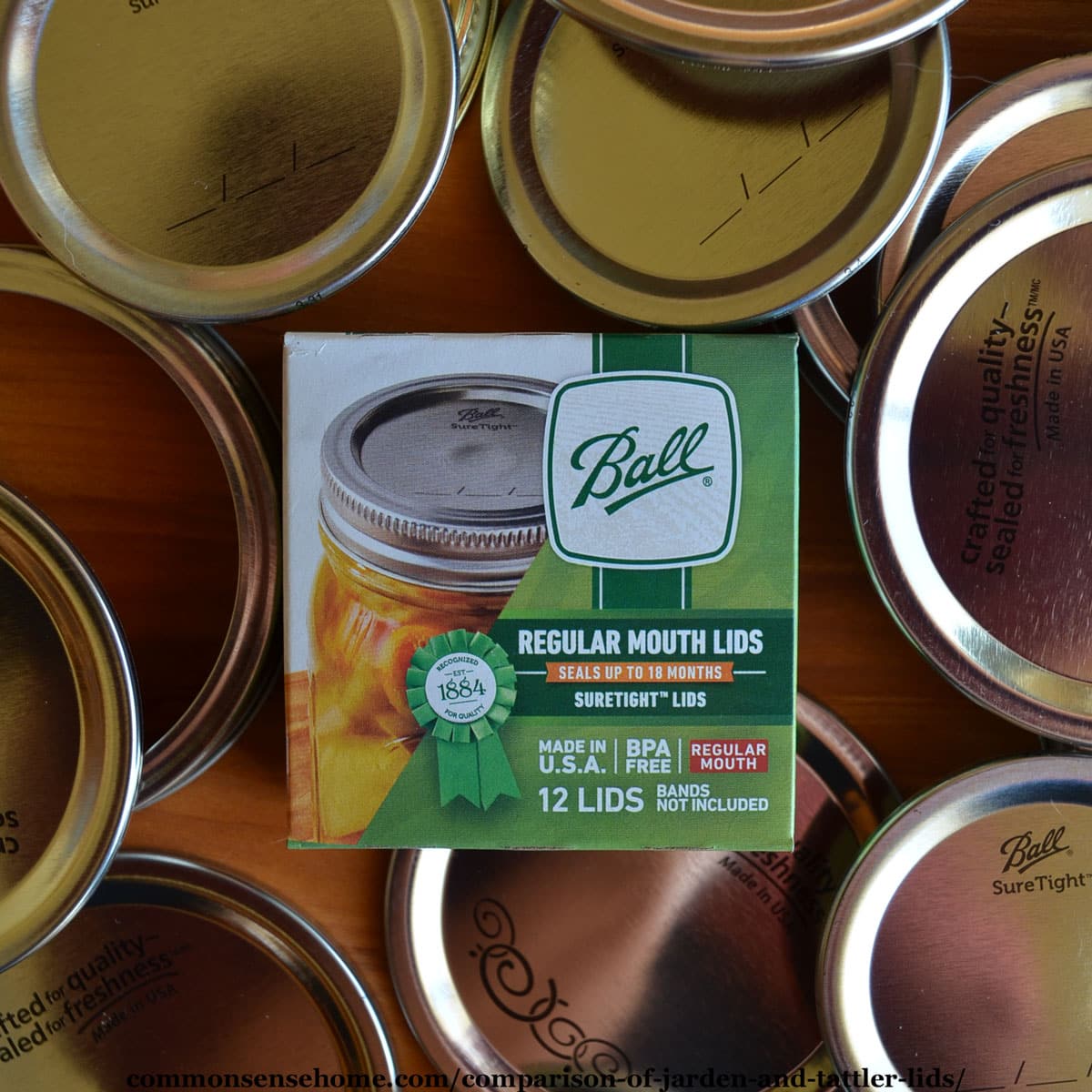
Jarden Metal Lids (Ball and Kerr brands, as well as others worldwide)
Jars and lids have been manufactured under the Ball brand name since 1885. Today, the closures are manufactured by Jarden Home Brands. Newell Brands purchased Jarden Corporation in 2016.
The two-piece caps using plastisol compound were introduced in the 1960’s and replaced two-piece caps having a latex sealing compound. All of the Jarden lids and bands are produced in their plant in Muncie, IN.
What are metal canning lids made from?
Jarden Home Brands manufacturers home canning lids using tin coated steel with an epoxy coating (to prevent corrosion) and plastisol sealant. The lids are BPA free since 2013.
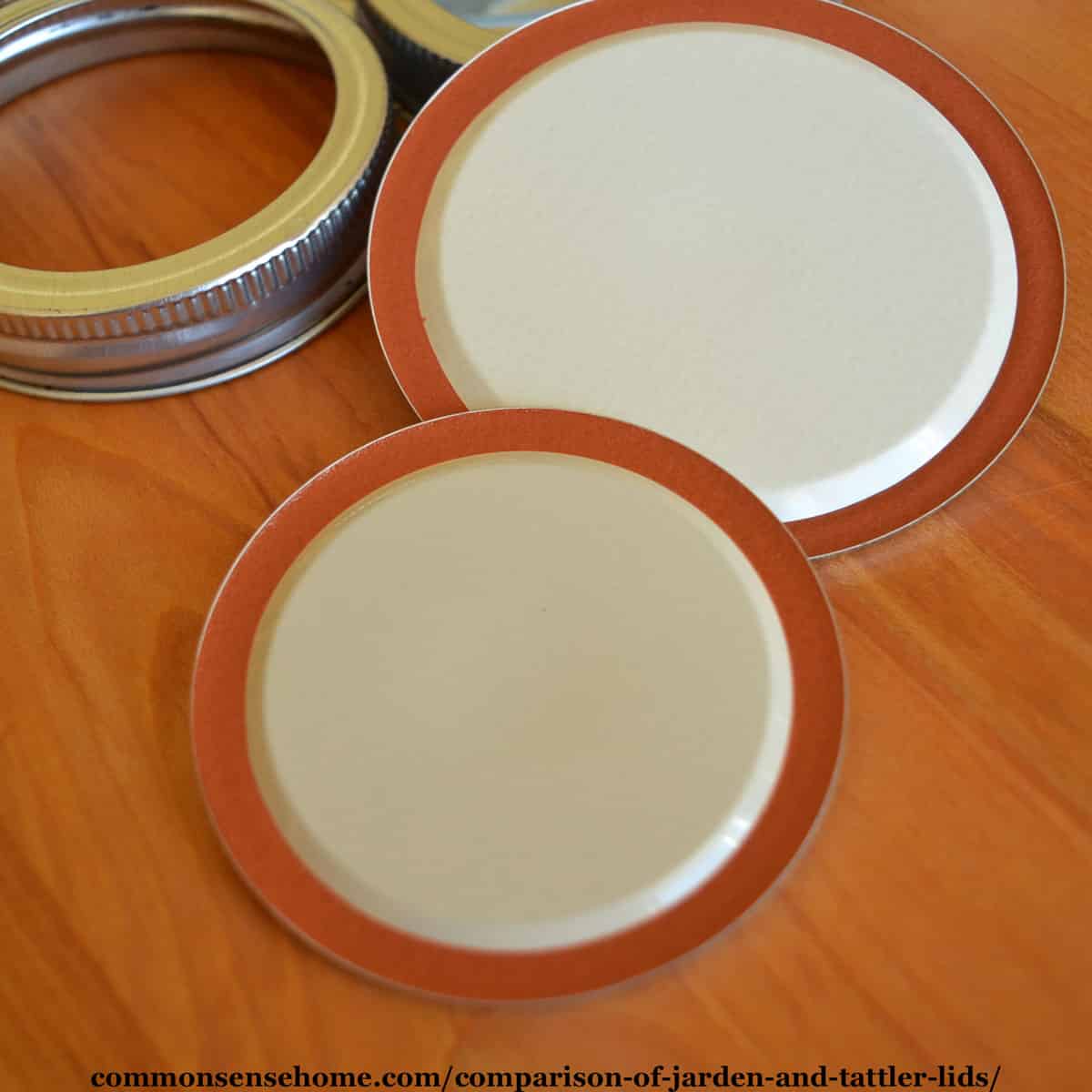
What safety testing has been done on the metal canning lids?
In-house scientists conduct ongoing quality and performance tests on bands and lids. They audit the integrity of incoming raw materials, monitor production runs against design specifications, and they conduct pack tests on the closures for shelf-life tests.
Ball brand and Kerr brand lids are used by the USDA and affiliated universities when conducting heat-penetration tests in the development of safe home canning guidelines.
Heat penetration tests were conducted by Jarden Home Brands working with university and independent authorities for the development of safe home canning recipes. Their closures stand up to this stringent testing protocol.
What support does Jarden offer to home canners?
Jarden Home Brands offers direct to consumer support services via 800#, email, Facebook, and written correspondence. We have an informative website at www.freshpreserving.com. It includes step-by-step videos, FAQs, and recipes to help the home canner experience successful results with each canning project.
Our Consumer Affairs staff has successfully completed the Better Process control School, works closely with our in-house scientists, and has nearly 50 years experience behind them.
Tattler Reusable Canning Lids
Loren Stieg, a tool and die maker, invented Tattler Reusable Canning lids in 1976, during a shortage of metal canning lids.
The Daily Sentinel shares the story:
The lids, designed for water-bath or pressure canning, are made of an injection-molded, food-grade plastic and fitted to a nitrile rubber gasket.
The name “Tattler” came about because Loren Stieg wanted them to make a sound when they sealed.
“They were going to make a noise and ‘tattle’ on themselves when they sealed,” Stieg said. “It just didn’t work that way and the design changed, but the name stayed.”
The Stiegs didn’t do much with the lids for 25 years. Then eBay and the Internet provided a willing market. This coincided with a burst of new interest in home canning and preserving.
Brad Stieg, who has a background working in materials management and logistics, decided to help his dad sell some of the inventory.
As all the lids manufactured in the 1970s started to sell out, Stieg knew he needed to start production again. The father and son incorporated in 2010 to resurrect the business.
What about Harvest Guard Reusable Canning Lids?
Harvest Guard Reusable Canning Lids was founded in 2019 by Brad Stieg, son of Tattler creator Loren Stieg.
Brad Stieg said, “I got back into the business to take care of the market the way I think it needs to be handled.”
A discussion in the Homesteading Today forum notes:
“In 2013 his son (Brad) forced a buyout, he thought he could buy out his father and run with the company that his father had built.
Loren managed to buy his son out in March of 2014 (much to his son’s surprise). There was a 5 year non compete clause in the closing contract.
Approximately 5 years to the day his “son” presented and marketed Harvest Guard, a knock off of Loren Stieg’s original canning lid.”
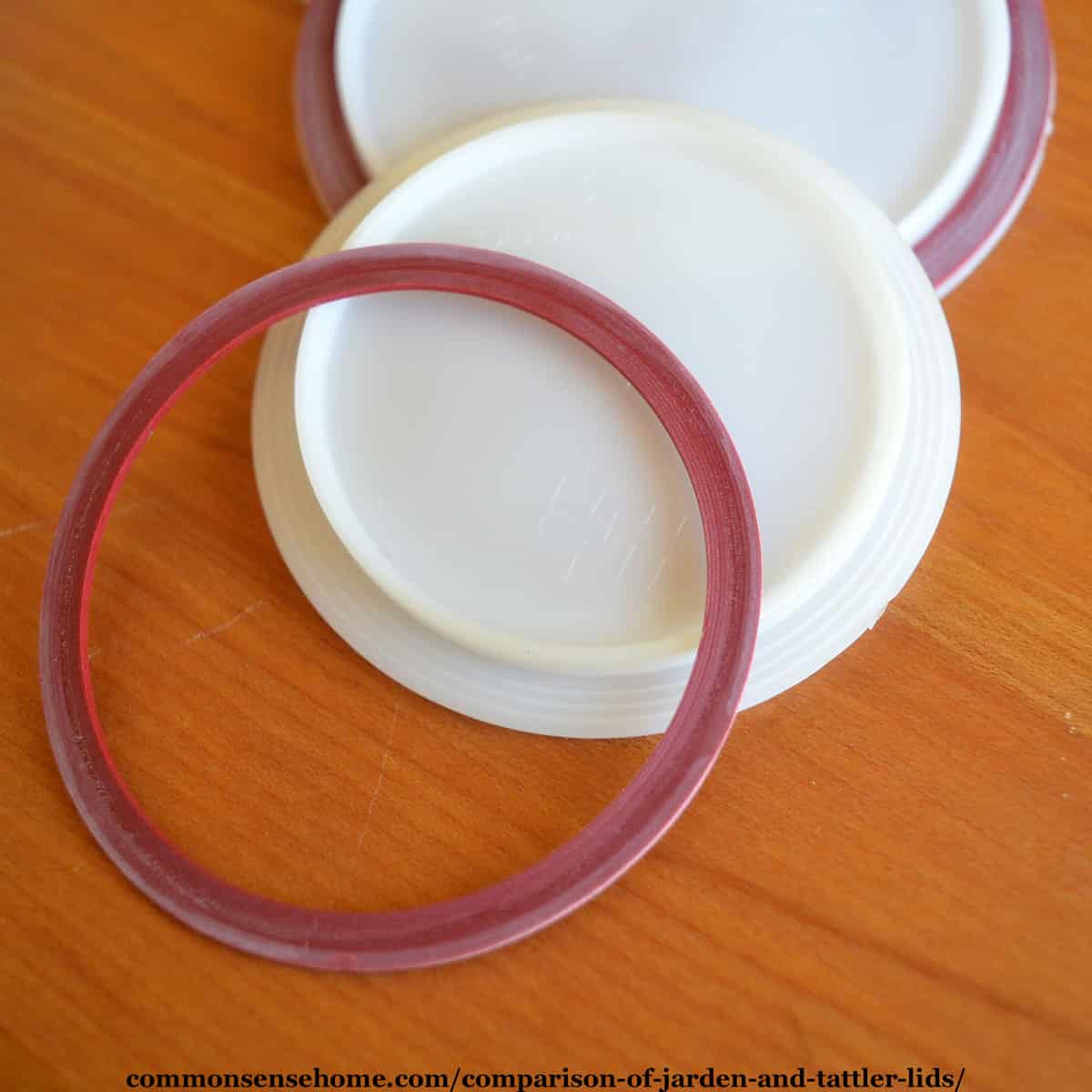
What are Tattler lids made of?
From the Tattler website: We utilize an FDA and USDA approved, food grade product known as Polyoxymethylene Copolymer (POM) or Acetal Copolymer.
The rubber rings (gaskets) are made from a food grade nitrile rubber and contain no latex.
What safety testing has been done on the lids?
From the Tattler FAQ page (now removed from the site):
Our customers state they have used the lids and rings for as many as 20 years.
Last summer (2010) we conducted a test using 14 lids and rings. The test materials were product we found in storage since 1976. They were used in both water bath and pressure canning tests over several weeks. All were reused 14 times without failure.
What support services does Tattler offer to home canners?
Tattler has a facebook page, phone number and email.
How to Use Tattler Lids
Tattler reusable lids come in wide mouth and regular lids. The plastic lids and rubber seals are used in combination with standard metal rings.
To use, prep your canning jars, inspecting for cracks and nicks.
Wash, rinse, and sterilize the mason jars. Scald the lids and rubber rings and leave them in the hot water until ready to use.
Fill jars as directed by recipe. Wipe any spills from jar rim, and screw on the lid.
From the Tattler website:
To get the correct tightness, place the jar on a counter top or other smooth surface, then place your index finger on the lid.
Would you like to save this?
Tighten the ring on until the jar begins to spin on the counter top (or other smooth surface). This is the perfect tightness for processing!
Process according to safe canning guidelines.
Once the process is completed and the jars are removed from your canner, let the bubbling die down (approximately 4-5 minutes).,
Place a towel over the still hot jars (for safety) and finish tightening the metal bands. Let your jars cool naturally to room temperature.
Remove the metal band and lift the jar slightly by the lid. It should be well sealed.
Do not use Tattler lids with alcohol, strong acids, chlorine or strong sunlight. These will break down the plastic of the lids.
Concerns about Tattler Reusable Canning Lids
There are three primary concerns about Tattler Lid – formaldehyde, seal failure, and air trapped in the headspace.
Formaldehyde
The Natural Canning Resource Book notes concerns about Tattler Lids:
“Tattler lids are composed of polyoxymethlylene copolymer, an acetal copolymer. …
(The author’s father, a chemist) noted that the copolymer is made from a trimer of formaldehyde called trioxane and other compound variations. Formaldehyde is a highly-toxic substance long known to be carcinogenic.
Some of the secondary additives are also potentially dangerous to human health and the environment.”
The book continues to give detailed evidence of uncombined formaldehyde in the lids.
From the Tattler website:
Many questions have been asked about the existence of formaldehyde in Acetal Copolymer. While it is true formaldehyde is present in trace amounts, research proves it is only released at very high temperatures.
Heating our brand of acetal copolymer above 460 degrees F (238 C) should be avoided.
Here is my concern:
Most of the formaldehyde is bonded and can only be released at extremely high temperatures. But could those trace amounts of unbonded formaldehyde shed into your food with normal canning use?
Risks should be minimal for home food preservation. The food inside the jar is not normally in contact with the lid.
Higher Seal Failure Rates
I noticed a significantly higher failure rate than standard canning lids, both during and after processing.
Though several studies of Tattler lids were proposed, I found results for only one.
In 2014, a University of Georgie grad student, Geetha Sivanandam, tested three types of canning lids – metal, plastic and glass. Three types of food (tomatoes, apple, and carrots) were tested under different conditions.
All three types of lids produced acceptable results, but only traditional metal lids produced 100 percent seal rate during processing and storage.
Retained Oxygen in the Headspace
Elizabeth L. Andress, Professor and Extension Food Safety Specialist from
The University of Georgia notes that there may be quality issues due to retained oxygen in headspace.
Because you finish the seal on Tattler lids when you tighten them, you don’t know if all the oxygen is out of the headspace.
With metal canning lids, the vacuum creates the seal.
I suspect this was the problem with this moldy jam canned using Tattler lids.
Some sites suggest increasing headspace by 1/4 inch when canning with Tattler lids to reduce failure rates. This may increase the risk of retained oxygen.
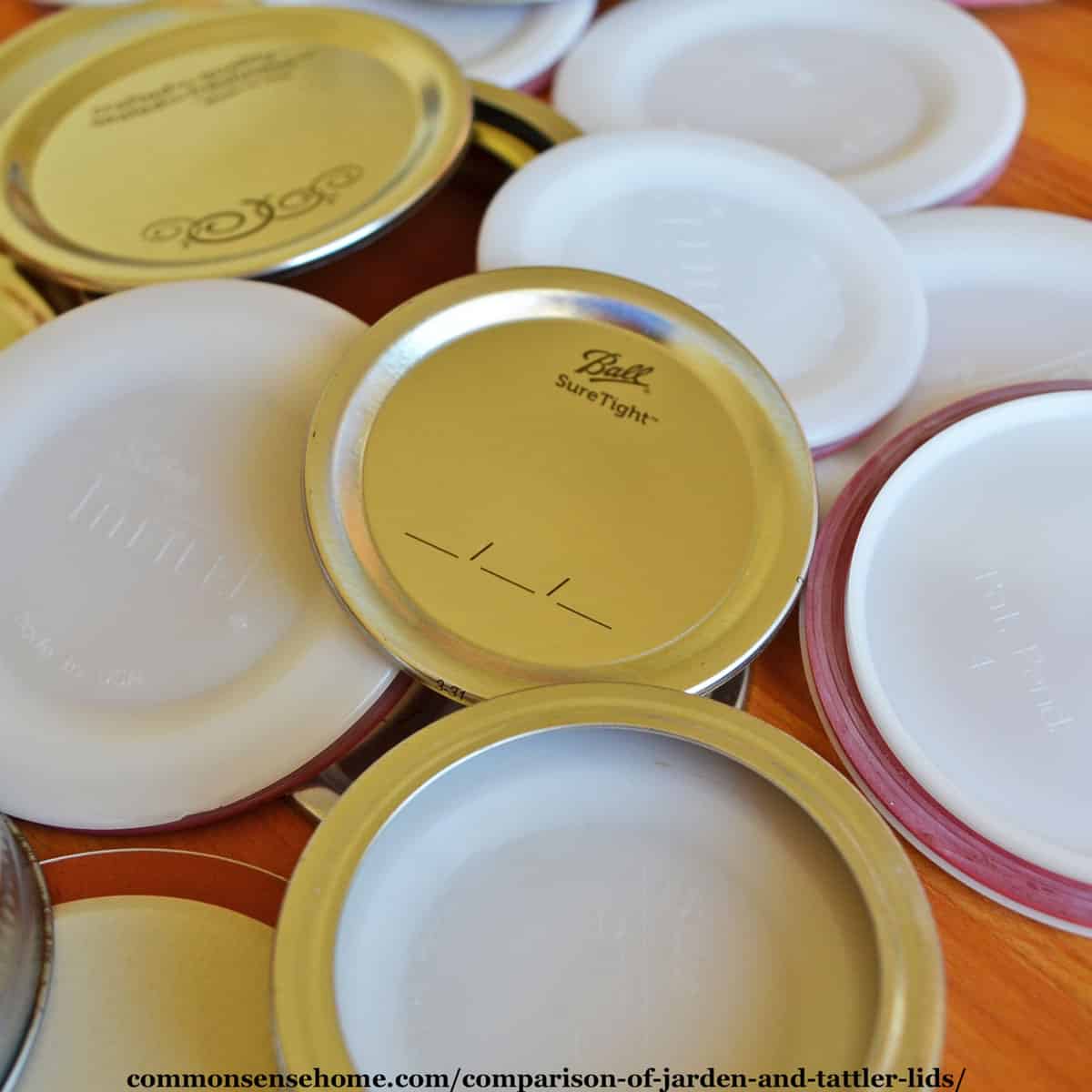
Comparison of Jarden Metal Lids and Tattler Reusable Canning Lids- Which is Better?
I prefer the metal canning lids, but many people prefer the Tattlers.
The metal lids are unmistakably sealed, and easy to use. I don’t have to worry about damaging the lids when they are pried off.
If I need to leave when a pressure canner is cooling down, I know the jars will seal. I can take them out as soon as I get home, instead of waiting to screw down the lids.
I appreciate the time, money and effort spent by Jarden Home Brands on testing product safety. They also have many years of experience and a dedicated customer support team.
The primary advantage of Tattler lids is that they are reusable. They cost more upfront, but should last for many years. With standard metal lids out of stock, Tattlers and Harvest Guard may be your only choices for home canning.
You may want to practice canning some water to get the hang of using reusable canning lids.
Either lid paired with quality home canned goods is a better choice than heavily processed grocery store foods.
Where to Find Metal Lids
Metal lids are sold out at many retailers, but Lehman’s still has American made bulk canning lids in stock. You can order the lids here.
More on Home Food Preservation
We have dozens of recipes and home food preservation guides, all listed on the Recipes and Kitchen Tips page.
Related Articles
- Botulism – Causes, Symptoms, Treatment, Tips for Safe Home Canning
- How to Can Food at Home – Quick Guide to Safe Home Canning
- Altitude Adjustments for Canning (Includes Printable Chart)
- How to Freeze Dry Food at Home
- Browse all of our Food Storage Articles
Originally posted in 2012, last updated in 2022.


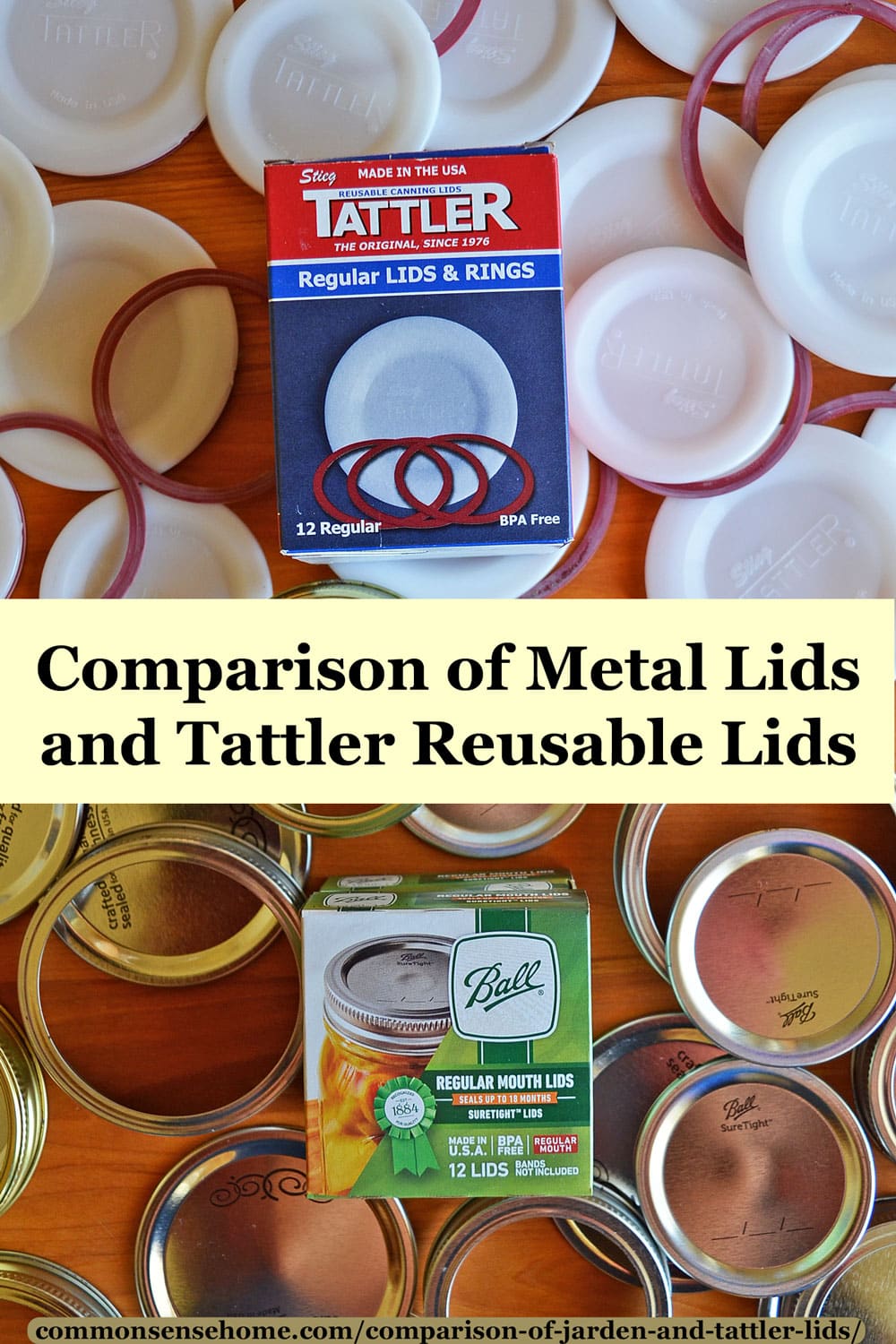
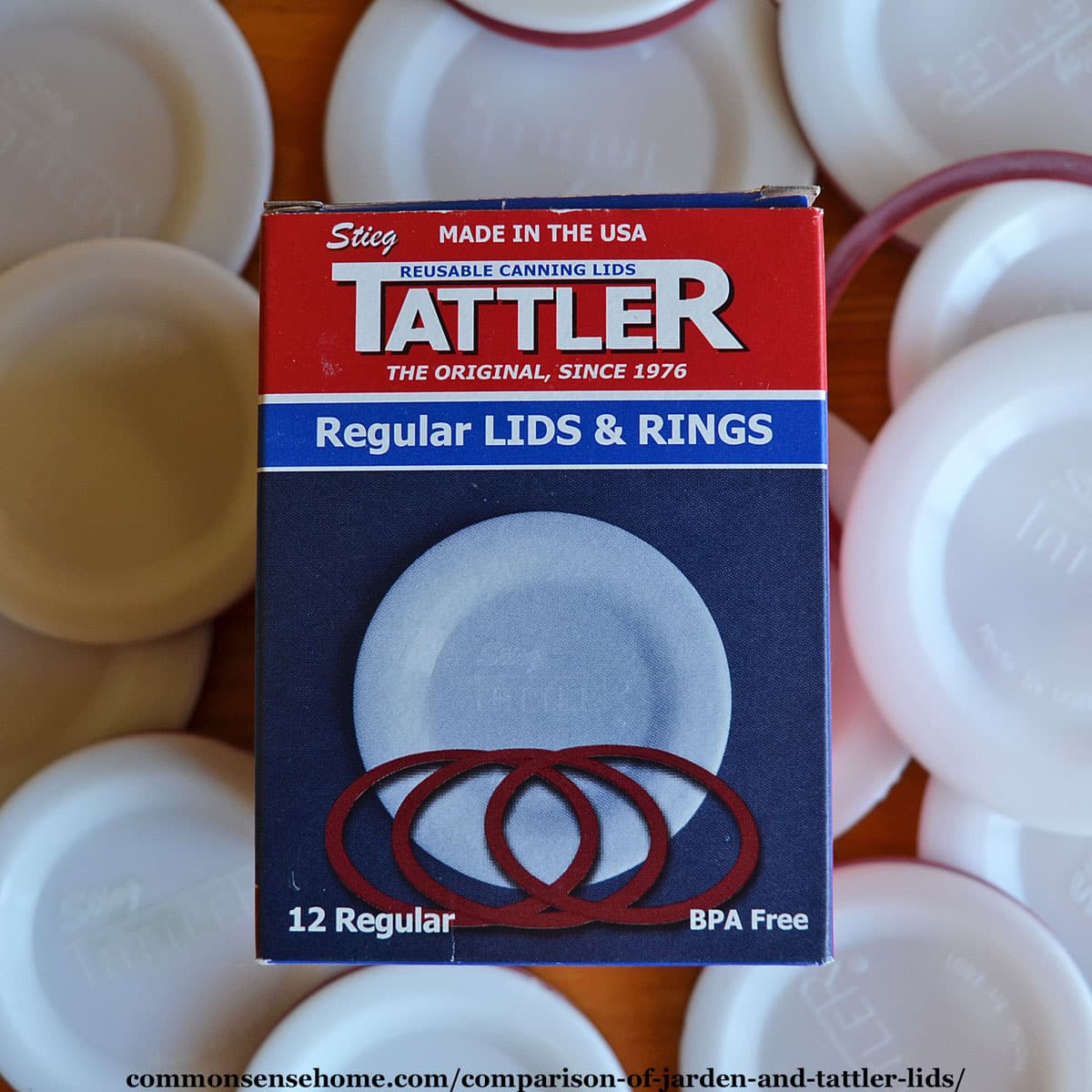
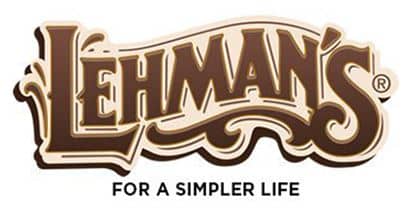
Very informative post! Thank you! Thought I would add to the discussion in case it is helpful to someone else. 🙂
I just started canning last year after putting it off for years because of wanting to avoid the metal lids. I have had extreme health problems and chemical sensitivities for several years now so just haven’t trusted the metal lids. I researched a lot and ended up buying a few boxes of Tattlers last year. I only used them for water bath canning and I maybe had 1 seal failure. All in all I was very pleased and loved using them. That said, it was my first experience canning so I had not developed habits with using the metal lids. I believe some failures may be attributed to that possibly.
This year I am delving into pressure canning and, again, am researching lids. I did my first batch last weekend using Ball canning lids. I am very sensitive and can detect tastes and smells that others can’t… and I could taste something unpleasant in my beans after pressure canning. 🙁 The lids may be BPA free… but I still don’t trust the materials and after that experience am hesitant to use them. I have been researching Weck jars and even the le Parfait jars as well. I may try Tattlers in the pressure canner … at this point I will probably trust the safety of them over the metal lids after my own experiences.
I’m glad the lids worked well for you. If you try the Weck jars, let me know how they work out. I’ve been curious, but not curious enough to hunt them down.
Just threw away the tomatoes I canned in October using Tattlers. They did not keep the seal. What a waste! I will never use those again.
Sorry you lost your tomatoes. That’s the most frustrating thing to me about the lids. The seal looks good, but then fails in storage. I’ve never had that happen with metal lids.
What is your opinion today with the new disclaimer on metal lids of only 18 months guaranteed seal?
It’s generally a good idea to rotate your canned good yearly anyway, but I’ve had some of the lids on jars for over two years with no issues. (Heck, the last of the massive batch of pickled jalapenos are still waiting to be used up, and I think they are five years old. No seal failure or signs of corrosion.)
I think the company just wants to protect themselves from people coming back with ten year old jars of canned goods saying, “Your lid didn’t protect my stuff.” The 18 month window also keeps them in line with National Center for Home Food Preservation guidelines for pantry rotation.
Thanks Laurie for sharing a great information. When I open a jar I take the lid off carefully so as not to damage it and then check the rubber and the inside of the lid and if it is marred I pitch it, but if it looks good I wash it and store it with my stash to reuse next season. In this way I reuse them multiple times, I don’t keep track of how many times one gets used.
Thanks Laurie.
You’re welcome.
Thanks for the update to this post. I recently read another post reviewing the reusable lids. They dont sound too great to me. That person had quite a high percentage of seal failures. Now I know you likely will not recommend this because it doesn’t “go by the book.” Back in the 70s when there was a lid shortage my mother learned that you CAN reuse the Ball lids and she has done so ever since, and I have also. So that is 40+years of testing it and it works! I honestly cannot imagine having to buy all new lids every year for the several hundred jars that I can! That would be costly! When I open a jar I take the lid off carefully so as not to damage it and then check the rubber and the inside of the lid and if it is marred I pitch it, but if it looks good I wash it and store it with my stash to reuse next season. In this way I reuse them multiple times, I don’t keep track of how many times one gets used. If they seal I have never had a problem of the seal not keeping because it was reused. There are always a few that do not seal and then I will just put it in the fridge to use in the next week and I pitch that lid. But I have a low percentage rate of those thst do not seal -much lower than some are having with the plastic reusable lids. BTW, I have also had a few new lids not seal. When I have used all my saved used ones then I always use 10-12 boxes of new ones yet also
Just thot I would put this out there so it can maybe help someone. If you have been throwing them away you can start now to keep the ones as you open your jars, so that you don’t have to buy as many new ones .
Yeah, I can’t recommend that since it goes against the manufacturer guidelines. If someone did want to do it, those products with short processing times (10 minutes in a water bath canner, for instance) would be more likely to be able to be reused with better results.
Thank you for the chemical warning information in the article. It is hard to find this type of info and risks posed – certainly companies are not forthcoming.
The BPA free may be just another scam to get us to buy replacements for everything only to find later that the chemicals used instead (BPS, etc) are equally bad or even worse. Much more is known about the danger of these chemicals now and here is a link about a recent study that alarmed even the scientists doing the study:”BPA isn’t just in bottles — a new report is sounding the alarm over receipts“.
I no longer trust what corporations say about safety and their commitment to customers, as it seems to always be followed by “we had no idea it was poison…” or “it was an unforeseen failure of XYZ that discharged these toxins into drinking water and vital wildlife habitat.”
Scotch guard, Teflon, fire retardant furniture, glyphosate, and thousands of other products were claimed to be ‘perfectly safe for humans’ over he years (as was smoking!) right up until the proof of deadly risks became so overwhelming they could no longer be hidden from the public. Public health agencies and the EPA have been captured by industry and nobody on the public payroll is looking out for us anymore. We’d be completely stupid to keep trusting their blanket assertions about safety.
Very little research has been done with respect to long term, low dose exposure on all these chemicals, so only time will tell. I try to pick “less bad” options, but even that choice ins’t always clear.
I read about the BPA in receipts some years ago in the book “Green Barbarians“. It’s amazing how many places with encounter chemical exposure in our every day lives. Just yesterday, I read results from another study that indicated that Teflon-like chemicals (Polytetrafluoroethylene (PTFE)) used in “easy glide” dental floss were migrating into gum tissue and the bloodstreams of users. It never ends.
I found out about the floss issue a few months ago and dug out the old waxed type I had in a drawer. Going to collect all the Glide containers and give them to Costco, etc, along with a piece of my mind for selling it. Researchers have linked Autism with chemicals and there have been some scary incidents reported in Hawaii, where big ag companies have test fields next to homes and schools. Spraying has resulted in medical emergencies sending many of the kids to hospital and causing emergency closures, along with huge increases in linked diseases. Locals successfully got a ban in place, only to be betrayed at a higher government level.
Estimates suggest there are between 25,000 and 85,000 different man-made chemicals in use today. They find dozens of toxins in umbilical cord blood, so babies are getting dosed before they are even born. It’s one heck of science experiment.
What about vacuum sealing?
Given my higher than normal canning seal failures, I have not tested with vacuum sealing.
As we are now into this global pandemic for 2020, vacuum sealing has taken off like gang busters. Dehydrators and the Food Saver vacuum jar sealing tops are completely sold out for the first time in company history. AND, in this era, good luck finding ANY metal lids. Thus, the search is on for substitutes. Can the Tattler lids vacuum seal ???
Additionally, Ball has CLEAR plastic lids that ‘should’ vacuum seal, but finding those is obscure too. And lastly, Berry Plastics Globally has plastic lids for jars.
ULine has a sonic sealer for canning jars. It’s $300 as of this posting. The seals are like that on most food condiment bottles with the finger peel-off. Similar to the pill bottle non-tamper peel off. This too will work for dehydrated food storage.
Otherwise, it’s very slim pickings.
I haven’t tried vacuum sealing the Tattler lids. In theory they should work, and I have seen others use them online.
Another option if you can’t get a lid that will vacuum seal would be to pop an O2 absorber and moisture absorber in any jar with a lid that seals well. Absorbers are still in stock, and that should accomplish similar results.
Yes, we vacuum seal and use the Multisorb O2 to remove moisture too.
I had found info on the Lehmans site about their reusable lids.
Value pack of 24 lids
Indefinitely reusable
Use with pressure canners, water bath or vacuum sealers
Use with standard metal bands
Made of FDA and USDA approved materials
Dishwasher safe and BPA free (see below for more info)
USA made
The formaldehyde issue should be nearly nothing when vacuum sealing as heat isn’t being used.
You have a great article here. However, many of the links are now dead. If you ever choose to revisit this topic, please add it as a link to this topic for your readers to follow along.
The Atlas-Mason jars were made from 1902 to 1964. And then under a trademark agreement, Borden with their Classico sauce uses the Atlas Mason on their jars. However, they were never certified for canning. BUT these work wonderful for vacuum sealing. There are an early Borden Classico jars with a thicker glass wall people used for water bath canning success. But the newer thinner wall works well for vacuum sealing only.
We’re slowly working through updating posts, but this one has never gotten a ton of traffic so it’s not high on the list. Given the shortage of canning supplies this year, I should give it a once over. It looks like Lehman’s is sold out of their reusable lids at this time.
I thankyou for your informative site, but now I’m unsure as to buy the Tattler lids I seen on sale for $6 a box. I was going to clean them out but now I’m not so sure.
I too have been canning for years and have just bought a pressure canner, I have also seen what can happen when the Tattler lids explode while trying to tighten the lids after removing them from the pressure canner. The other thing is I have noticed too over the years how much thinner the rubber coating has become on the metal lids, compared to today. I always check them before use for bare spots on the rubber, thats how bad they are getting.
Just a thought, but has anyone tried to combine the 2 ? Put a metal lid over a rubber ring ? Any chance something like this could work ? You don’t have to tighten lids after they come out and could hear it pop down, plus they could be both reused. Wishful thinkin …………I guess they are like the big Car companies, want you to keep on buying, so they don”t make them last.
The Tattler lids have potential issues with retained air in the headspace due to lack of flexibility in the lid itself (because of the hard plastic). With the metal lids. the seal is formed as the vacuum is formed inside the jar, and the distinctive “ping” is a sign of that seal. The Tattler seal is formed when the user tightens the lid. It’s an inherent design flaw, and I think layering the lids would only make it worse.
There is a level of protection in the single use lids, in that you are more likely to get a good seal each time because it is undamaged. Although they can’t be reused, they can be recycled. The jars can be reused for years, so for me it’s worth the investment in the lids.
In the early 1950’s we sometimes used wax (paraffin or bee’s wax) to provide a barrier to the lid and extra seal. This provided a gas tight lump on top of the food. I wonder if this would help today for concerns expressed. I got to lick the spoon (treat for a kid making cake, pies, preserves)!
Wax is no longer recommended. The reason is explained on the Center for Home Preservation website:
“If I’ve got to get out the door when a pressure canner is still waiting to cool down, I can rush off without having to worry about failed seals. ”
You run the risk of flat sour when you do that.
I like the metal also but they are making the rubber seal smaller and thinner. The box states only good for a year and I sometimes have cans on shelf that are older than that ..just opened a 4 yr old can and it was great! It is a shame to think that the seal only has a YEAR life. I will gladly pay a little more to the greedy Company for a better seal!
Yeah, I regularly have jars that are two seasons old, because we’ll have a bumper crop one year of some produce and then little the next.
I take that to mean a shelf life in the box, unused… rather than once it has sealed on the jar. iow, iow, buy new ones every year instead of using leftovers from the year before.
Laurie, did I understand that you have bought lids in bulk for future use and they have been fine?
I purchased 2 cases of lids and have been using them for years. No increased rates of seal failure or any other issues.
Laurie,
Thank you for doing the research on the lids. I was looking for reusable lids and came across the plastic ones. After reading your article I think I will go with the Weck glass ones that one of your respondents mentioned.
It sounds like the Tattler ones were made without any materials testing done. It would be very easy for them to determine what if any compounds in the material are being lost during repeated canning processing. A 14 day test is not sufficient to determine anything about what may be lost during normal repeated use.
A simple set up would be to actually can with them. After each use pull one lid off test and run the lid through a gas chromatography (GC) test to determine how much of which compound has been lost from the lid. If something is being lost it is either going into the water bath, atmosphere or food during the processing of the canned item. They should know how many times a lid can be safely reused and whatever that number of times is would tell them how many lids should be included in the test. For example if they can be reused 20 times then 20 jars, lids and seals should be processed in both water bath and pressure cooker for a total of 40 set ups. This way run one would have 20 each type of processing, pull one lid from each for GC analysis after run one, 19 of each type of processing for run #2 then pull one lid from each for GC etc until all have been processed. Ideally this should be done several times with different food types done each time. Batch of 40 the first time done with high acid food (same food for all 40) then repeat another 40 with low acid.
For those reading this that do not know what GC is:
Gas chromatography (GC), is a common type of chromatography used in analytical chemistry for separating and analyzing compounds that can be vaporized without decomposition. Typical uses of GC include testing the purity of a particular substance, or separating the different components of a mixture (the relative amounts of such components can also be determined).
I would also be surprised if the gasket could withstand that many reuses without having taken a set, meaning it no longer would have any compression left. If the gasket can no longer be compressed it is not going to make a good seal. Nitrile rubber is good for high temperature applications, however, where you typically see it used is in rubber hoses that are hooked up and sealed with a clamp and not removed and replaced a bunch of times for this very reason (look under the hood of your car). If it is removed it has the clamp to be used all of the way around to tighten it back down to the outlet it is attached to. In this application if the lid is not being tightened down immediately upon removal from the water bath/pressure cooker there is therefore an opportunity for bacteria to get into the jar.
Just because a government agency does not require MSDS be retained for safety reasons that does not mean a company does not or will not require them from their vendors. How do they know what they are making their product from or that it is safe if they do not review this information at a minimum from a quality and safety perspective.
Thanks again for your work to do this article.
Laurel
Thanks, Laurel, for your thoughtful and intelligent response. I completely agree with your point about repeated use of the gasket and the opportunity for unsafe canning conditions. It would also seem like the company has expanded enough that if they really wanted to get proper testing done, they should be able to afford it. Odds are they would qualify for some type of grant and could hire out the testing done at a university for a reasonable rate. I may be mistaken, but it appears like they don’t even want to consider the option.
Hello; I was wondering what Laurie is now thinking about the increase in reported seal failures by experienced canners and Jarden’s ignoring their phone calls. Laurie reported that Jarden talked about how long the “Ball” company manufactured canning lids but never answered as how long Jarden had been manufacturing the lids. So no question as to what manufacturing changes had Jarden made had been asked and no answered was possible.
I found your “research” one sided to the point of prejudice and wondered why you would not have included the wecke bottles based on the health problems you discussed, but greatly enhanced regarding tattler lids.
You did not report that Jarden boosts that between all their experienced researchers that have over 70 years experience. 70 yrs experience? My sister and I have more combined canning experience then their professional canning researchers.
You have been remarkable silent on the sealing lid failures of the Jarden-manufactured lids.
I haven’t had an increase in Jarden lid failures, so I haven’t contacted Jarden about said failures, nor was I aware of Jarden ignoring home canners. I’m not omnipotent, I can only share what I’ve run into in my own experience. If the failures are recent, they could be due to the changes to make the lids BPA free. This article was published before that happened.
I didn’t include Weck bottles because a) the article was pretty long already b) the Weck bottles are not readily available off the shelf in most areas and c) the Weck bottles are quite expensive.
Since you have so many years of experience, you are welcome to share your lid recommendations. If you’ll note, while I didn’t get into a discussion of the Weck lids in the post, Laurel provides some good information on why she is planning to use Weck jars in the comments.
This post is years old so some may think it lacks relevance but I don’t think that’s true. Any business that’s unwilling to even talk about issues pertaining to people’s health when using their products can’t be trusted. That’s not something that changes with time. I was considering buying a set of tattlers, despite this article, but something about the tone and level of offence taken in this reply makes me suspect a few things and none of them are good. Long story short, I’ll stick with Ball.
hi seen on the internet plastic lids are made of #7 plastic and I was told that’s not safe and how safe are the rubber bands nobody says anything about that? I’m new at canning. do you use plastic lids or medal thank you
I prefer the metal ones, but many people do use the plastic.
I have been wondering what people did before something like Ball or Kerr lids. If you can’t just go to the store or order online, can you still can? Other than Tattler are there any other reusable forms of canning?
Before the current two piece jar lids, there were glass lids with rubber gaskets and metal clamps, and one piece zinc lids. Before that, there were glass jars with sealing wax and tins lids. Mason jars revolutionized home canning via their relative use of use. A Brief History of Home Canning in America provides more details.
I bought a bulk supply of canning lids, so I am set for quite a while. they easily store for years. Weck jars also have reusable glass lids, but are quite expensive.
Thanks for all the info. My original question from Ball or Kerr was what is the shelf life of their lids? I too have purchased several for a ‘just in case’ scenario. So do you know how long the lids will still be effective or for how many years?
Thank you again for all the information you have researched.
I do also have the Tattlers and I have not come to any conclusion about them as I did not know if I needed to use up the tin lids before the rubber seal on them deteriorated.
This canning lid discussion on Garden Web seems to indicate 5-10 years of shelf life, and this EHow post claims that Jarden Home Brands says 5-10 years if properly stored.
I just read an article that Ball lids now only keep their seal for 12 to 18 months. If that is true then that is unfortunate. 🙁
I did some digging about that statement, and it seems like that’s the new “official” statement, based of FDA safe canning recommendations. I suspect that the company feels obligated to put out a hard date keeping close to government guidelines, just to cover their backsides. Otherwise, they could be sued by someone who stored jars for years who ate something and got sick.
The quality of canned food does degrade with age, and it’s best to rotate stock annually. That said, I have kept high acid foods for several years, with Ball lids, and no signs of degradation in the lids or seal. My canning storage area is cool, dry and dark.
For truly long term storage, I’d recommend freeze drying, which can give foods a shelf life of up to 25 years, give or take. See https://commonsensehome.com/home-freeze-drying/ for more information.
Before the two-piece metal lids, there were Crown jars, which have a three piece lid much like the Tattler, with a rubber gasket (far thicker and sturdier than Tattler’s), a glass lid and a zinc ring. Like Tattlers, they have to be tightened, loosened, processed and retightened with the same risk of retained oxygen in headspace. THANK YOU for explaining all the problems I’ve had with these over the years! Many Crown jars are still in use, including some in my own kitchen, and the rubber gaskets are still manufactured by Viceroy and sold under the name “Fruit Jar Rings”. I far prefer the modern jars and metal lids, but my Crown jars were free and I am using them while I gradually purchase replacements. I don’t trust them in a pressure canner because of the sealing problem but also their age. Each jar bears a date of manufacture and many of mine are dated in the early 1930s, most of the rest in the late 1940s. I like to think of the women who canned food in these jars during the Depression, World War II, and the postwar recovery.
I have some beautiful vintage wide mouth cup jars with zinc lids that don’t lock on. I believe at that time they relied on wax to seal the tops of jellies. What stories these old jars could tell!
First hit on google for plastisol:
“Plastisol is a suspension of PVC particles in a plasticizer”
YUM.
I just wanted to mention that Tattler lids are NOT approved for canning by the USDA. They are made of plastic that has been deemed foodsafe, but shouldn’t be used to can.
I have used them and they work great. But now that I am opening some of my jars of tomato sauce I put up, I am ending up with stained lids. Yuck! They stated making red lids, but these cost more than the white ones.
Thanks so much for that very detailed information, especially all your conclusions which I find to be thoughtful. I knew there was much more to it. Think I’ll stick with the metal lids for now until someone invents the perfect reusable one.
I love my Tattler lids. took me a couple times to really get the hang of them, now I never have seal failures. I too was concerned about the formaldehyde in their product so I emailed the company directly. They have wonderful prompt customer service. I also posed the scenario to them that is on this post, “A+B=C leftover unbonded formaldehyde….”etc.
This was Tattler’s reply:
“Thank you for your response. First off, your use of the word “speculation” with regards to the presence of formaldehyde is correct. People are speculating about that which they do not know. Formaldehyde is not part of the creation process of our plastic. It is a degradation product. Therefore the A+B=C scenario is not correct. Formaldehyde only manifests itself when very excessive temperatures are reached, i.e. 460 degrees F or greater. Under these circumstances it is likely the molecules will break down and release formaldehyde. However, this is not a reasonable scenario in a home canning environment.
By the way, the chemical smell when you open the box is not the plastic, it is the nitrile rubber rings in the box.”
Very thorough and I would have loved to come across this when I was looking for info on tattler lids. I went ahead and purchased quite of few and though I do prefer the metal lids, I like the convenience of having these in my canning supplies. I also believe in being prepared for whatever may come down the road, (i.e. bad economic times) and I like that I’ve already made the investment in a long term reusable item. I’d hate not being able to can my garden surplus because lids may not be available. One thing that I really dislike is that the first time the tattler lids are put to use they tend to leave a bitter aftertaste at the surface where the food comes in contact with the rubber seal. I don’t have that problem after they’ve been used once or twice – just on a new lid right out of the box.
I tried the Tattler lids this year and didn’t like them, which is unfortunate since I have so many! I think they will be my emergency stash. The main thing I didn’t like was I wasn’t SURE they were sealed. The metal ones pop loudly and are easy to determine afterward both by sound and the indentation. I didn’t hear the Tattler lids pop but perhaps I wasn’t in the room at the time. It wasn’t as easy to tell by tapping if they were sealed either but again that might be because I was expecting the distinct sound of the metal lid. It said to try to open it to see if it is sealed. I did decide that one sounded different from the others and for sure it did open right up. I think I didn’t wipe the rim of the glass well enough but I rarely have that prolem with the others. I also don’t like having to tighten the when I take the out (when they are hot). I might try one more time with rhubarb, because of the acid content, but they aren’t my favorite right now!
Charlotte – thanks for sharing your experience.
Thanks for sharing and going into so much detail. BPA is def. a concern for me and so is formaldehyde! I believe all things should be natural if at all possible and when it concerns the food for my family I want to know if it’s being affected when canning. I see someone mentioned about canning with glass lids?! That is interesting! I’m going to check into that!
Thanks for the great post Laurie! I appreciate the facts about both types put there together. One of the biggest concerns for me, which has been made even stronger with this post, is the lack of customer service from Tattler. Brad from Tattler was downright rude in your previous post on the lids and then not commenting for an article that will be comparing the two types of lids? Why not? Besides a deplorable lack of manners, why would you not want to get the safety information out there to gain more prospective customers?
It sounds like the Jarden people were very forthcoming, and I especially appreciate the information about BPA, both from them and the other links that you provided.
Thanks so much!
If Brad decides at a later date he’d like to provide additional information, he’s welcome to do so. I wish he had been more cooperative, but hopefully there’s still enough information for people to make an informed decision.
Even better, switch over to Weck canning jars, they are a European brand, with glass lids! Pricey, but great quality.
Rebecca – the Weck’s are great as far as toxins go, but face the same issues with a potentially incomplete vacuum as the Tattlers. Still, I’d like to try them. Many of their jars are just plain beautiful.
WOW! Amazing amount of much-needed facts! Thanks for posting. You obviously did your homework!
Thanks for your words of support, Robin.
Great post! I’m glad to hear that even the Europeans don’t think that the BPA is a problem. I’ve been a bit worried about it and went ahead and purchased some of the Tattler lids (quite a few, actually). I have been canning for years and followed the instructions to the t, and had pretty crummy results. I’ve had to throw out a lot of food that I canned with those. So I leave them sitting on my self now. My thought is that in the case that other lids are not available for some reason I will try them again.
Thanks again!
Thank you for sharing your experience, Lisa.
Thank you for this post!! I wondered about this,so I am grateful for the time and effort you put in to find this information. I appreciate it!
You’re welcome, Darlene.
On thing I found with the Tattler lids and rubber rings is that a section of the rubber ring can fall inside the jar thus not allowing it to seal.
Thanks for your input, Taneil. I also found the rubber rings somewhat difficult to clean after using them for sticky foods (like peaches). The peach goo got in all the little crannies, even with soaking and scrubbing with an old toothbrush.
Thanks Laurie for all the research and great information. Hopefully once this post goes viral someone at Tattler will get off there butts and call you to comment on the post or give you the answers to the questions you requested. I will help you out by spreading the information! Thanks SB Canning!
Thanks, SB.